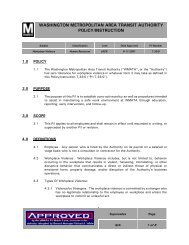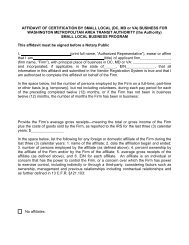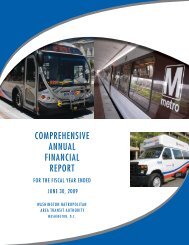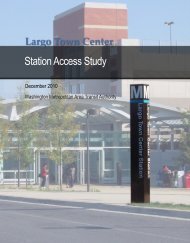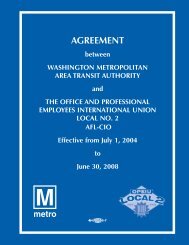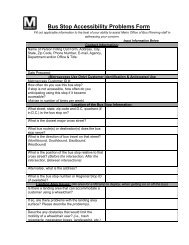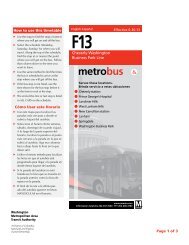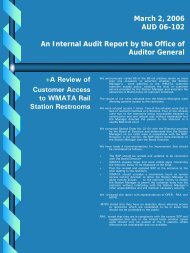Naylor Road Metro Station Area Access and Capacity - WMATA.com.
Naylor Road Metro Station Area Access and Capacity - WMATA.com.
Naylor Road Metro Station Area Access and Capacity - WMATA.com.
Create successful ePaper yourself
Turn your PDF publications into a flip-book with our unique Google optimized e-Paper software.
Time to Reach a Point of Safety<br />
Calculating the time to reach a point of safety (defined as the street level <strong>com</strong>pletely outside of<br />
all station structures) employs the same principle. After clearing the platform, the capacity of<br />
faregates (assumed to be open in an emergency) <strong>and</strong> the width of the mezzanine exit may be<br />
limiting factors in how quickly the station occupant load reaches a point of safety. In addition<br />
to the time spent walking along the exit path, the analysis accounts for the wait time at each<br />
potential choke point along the way. The analysis found that wait times at faregates <strong>and</strong><br />
mezzanine exit would be non-existent, as the person-per-minute throughput capacity at each<br />
potential chokepoint increases as the passengers get closer toward the exit. In other words, the<br />
platform-to-mezzanine stairways <strong>and</strong> escalator are the only bottleneck in the station. Passenger<br />
queues would form on the platform in an emergency situation because of the limited throughput<br />
capacity of the stairways <strong>and</strong> escalator. These vertical circulation facilities would act as a funnel,<br />
allowing only some of the passengers through. The <strong>com</strong>paratively larger throughput capacity<br />
of the faregates <strong>and</strong> the mezzanine exit ensures that the limited number of passengers that have<br />
already descended to the mezzanine can proceed without waiting in additional queues.<br />
Table A-15 details the analysis inputs used to calculate times to clear the station platform <strong>and</strong> to<br />
reach a point of safety.<br />
Table A-16 summarizes the vertical, faregate, <strong>and</strong> mezzanine exit capacity, as well as the walking<br />
time for the longest practical route to reach a point of safety under 2012 <strong>and</strong> 2040 ridership.<br />
Tables A-17 <strong>and</strong> A-24 provide a detailed breakdown of the NFPA 130 morning <strong>and</strong> afternoon<br />
peak analyses.<br />
Table A-15: NFPA 130 Analysis Input Data<br />
Category Value Units Source<br />
<strong>Metro</strong>rail crush capacity 220 Passengers/car <strong>Metro</strong> Manual of Design Criteria for Maintaining <strong>and</strong> Continued Operation<br />
of Facilities<br />
Escalator width 48 Inches <strong>Metro</strong> Manual of Design Criteria for Maintaining <strong>and</strong> Continued Operation<br />
of Facilities<br />
Stair width 60 Inches <strong>Metro</strong> Manual of Design Criteria for Maintaining <strong>and</strong> Continued Operation<br />
of Facilities<br />
Surge factor 1.3 <strong>Metro</strong> Ballston-MU <strong>Station</strong> Exiting<br />
Walking speed 124 Feet/minute NFPA 130: St<strong>and</strong>ard for Fixed Guideway Transit <strong>and</strong> Passenger Rail Systems<br />
Vertical walking speed (down) 48 Feet/minute NFPA 130: St<strong>and</strong>ard for Fixed Guideway Transit <strong>and</strong> Passenger Rail Systems<br />
<strong>Capacity</strong> for stairs <strong>and</strong> stopped 1.41 Persons/inch/minute NFPA 130: St<strong>and</strong>ard for Fixed Guideway Transit <strong>and</strong> Passenger Rail Systems<br />
escalators (down)<br />
<strong>Capacity</strong> for faregates 50 Persons/minute NFPA 130: St<strong>and</strong>ard for Fixed Guideway Transit <strong>and</strong> Passenger Rail Systems<br />
<strong>Capacity</strong> for ADA or emergency<br />
faregates<br />
75 Persons/minute NFPA 130: St<strong>and</strong>ard for Fixed Guideway Transit <strong>and</strong> Passenger Rail Systems<br />
87 | Appendices





